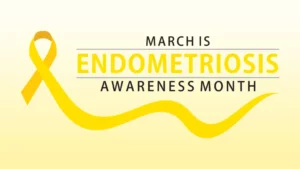
Did you know that Women’s History Month is recognized in March? It is a celebration of women’s contributions to culture and society throughout history. March also happens to be Endometriosis Awareness Month. Endometriosis is an inflammatory condition that affects an estimated 1 in 10 women, or people assigned female at birth (Zondervan 2020). It is especially common between child-bearing years—for most people the ages that they are in the workforce. Endometriosis can have a negative effect on the quality of life for those that suffer from this condition. In this blog, we’ll discuss what endometriosis is, the signs, how to get help, and how to support those that have it.
What is Endometriosis?
Endometriosis is an inflammatory condition in which tissue similar to the womb lining grows outside of the womb. It can grow in other places in the uterus such as the ovaries or fallopian tubes. Unlike the shedding of the womb lining during the menstrual cycle, this lining growing outside of the womb cannot be shed. This leads to pain, adhesions, an inflammation in the uterus. Unfortunately, no one knows for sure what causes endometriosis. However, researchers suggest it can be due to genetic factors, hormones, and problems with menstrual cycles. Endometriosis can also not be prevented. This is why it’s important to talk to your doctor regularly and keep an eye out for any symptoms.
Symptoms
- Painful menstrual cycles; dysmenorrhea.
- Pain during or after intercourse.
- Pain with bowel movements or urination.
- Excessive bleeding during menstrual cycle.
- Infertility.
- Abdominal cramping and pain.
- Spotting or bleeding between menstrual periods.
Effects in the Workplace
The effects of endometriosis vary based on the symptoms someone has. Having a medical condition that results in tough symptoms is likely to affect everyday tasks—including at work. Here are some of the effects endometrioses can have on employees:
- Pain can make it difficult to physically show up to work.
- Employees may need to take more time off.
- Frequent medical appointments.
- Increased stress levels.
- Low quality of sleep.
How to Help
The best thing that you can do is be aware of what endometriosis is and be open to conversation. It can be a difficult subject to talk about so creating a safe space to grow, learn, and discuss is important for the ability to be on the same page as your fellow colleagues. Not sure where to start? Here are some tips on how you can support those that suffer from endometriosis.
- Educate yourself. Endometriosis, Foundation, Endometriosis Foundation Of America | EndoFound has a plethora of resources.
- Build a supportive workplace environment. Be open to conversations, raise awareness, and normalize talking about it.
- Flexible work arrangements. If you are in a management position, be open to the possibility of work-from-home or other arrangements for those that suffer from endometriosis.
- Job modifications. Encourage employees to take breaks if necessary or put off physically demanding parts of their role for when their symptoms begin to resolve.
- Be there for each other and offer support. Encourage research and professional help.
Reduce the stigma around endometriosis and help the women in your life by sharing resources. The best thing that you can do is be supportive and get involved. Some online groups to get involved with include the Endometriosis Association Online Community and MyEndometriosisTeam.